Naksan Provincial Park (낙산도립공원)
8.0 Km 10954 2018-01-25
59, Haemaji-gil, Yangyang-gun, Gangwon-do
+82-33-670-2518
Naksan Provincial Park takes up 24km of shoreline in Yangyang, Gangwon-do. The park is centered on Naksansa Temple and Naksan Beach, but includes Osan, Dongho, and Hajodae Beaches, as well as many lakes and cliffs. The park is a great place to learn about Korean culture, including Buddhist culture at Naksansa Temple and other cultural relics, and the shoreline cliffs of pine trees. The park is a popular attraction in the summer, when visitors can swim in the ocean and play in the sand along the coast.
Naksan Beach (낙산해수욕장)
8.0 Km 70554 2022-12-22
59, Haemaji-gil, Yangyang-gun, Gangwon-do
+82-33-670-2518
Naksan Beach is one of the most famous beaches in Yangyang, located in Joseon-ri, Yangyang-eup, Yangyang-gun, Gangwon-do. Since its opening in 1963, it has attracted more than 1 million visitors each year, its reputation being rivaled only by the Gyeongpodae Beach on the east coast of Korea. The 4 kilometer-long sand beach contrasts magnificently with the lush pine trees of the area. The water is less than 1.5 meter deep, making it a good place for all ages. Naksanhang Port marks one end of the beach, behind which Naksan Mountain, the location of Naksansa Temple, can be found. The other end has a lake formed at the delta of Namdaecheon Stream, which originates from Seoraksan Mountain. Many cafes, convenience stores, restaurants, and accommodations cater to the needs of the visitors. The beach sees considerable traffic in winter as well, when it serves as a popular venue for sunrise-watching, particularly for the New Year’s Day festival.
Geumgangsan Daegehoetjip (금강산대게횟집)
8.4 Km 169 2021-03-20
8-5, Haemaji-gil, Yangyang-gun, Gangwon-do
+82-33-671-5207
A restaurant that sells a variety of seafood. The best menu at this restaurant is king crab. This seafood restaurant is located in Yangyang-gun, Gangwon-do.
Jeongin Hoesikdang (정인회식당)
8.4 Km 18009 2024-02-16
32 Naksansa-ro, Ganghyeon-myeon, Yangyang-gun, Gangwon-do
Jeongin Hoesikdang, situated near Naksan Beach in Yangyang, specializes in mul hoe (cold raw fish soup) and saengseon jjigae (fish jjigae). It prides itself on using fresh fish, sourced from nearby ports and used within a day of purchase. The restaurant's signature dish is sanureok maeuntang (spicy rockfish stew). Other popular menu items include modeum mul hoe (assorted cold raw fish soup), seongge albap (sea urchin roe rice), and ojingeo hoe deopbap (raw squid bibimbap). Additionally, soups like gomchi tang (spicy moray eel stew) and haemul tang (spicy seafood stew) are also highly recommended. For guests interested in local attractions, the scenic Naksansa Temple and Naksanhaebyeon Beach are nearby.
Uisangdae Pavilion (낙산사 의상대)
8.9 Km 16142 2021-04-12
100, Naksansa-ro, Yangyang-gun, Gangwon-do
+82-33-672-2447
This pavilion is located on a seaside cliff on the way from Yangyang’s Naksansa Temple to Gwaneumgul Cave of Hongnyeonam Hermitage. The word “dae” in Uisangdae refers to a building built at a vantage point for areas with beautiful scenery. Indeed, the view of the East Sea and the coast from Uisangdae Pavilion awarded its recognition as one of the Eight Sights of Yangyang, and a must-visit place for all visitors to Naksansa Temple. Jeong Cheol (pen-name: Songgang), a famed scholar and writer of the poem Song of Diamond Mountains, chose the pavilion as one of the Eight Sights of Gwandong, and the pavilion is today one of the popular sites for sunrise-viewing on the east coast of Korea. Together with Hongnyeonam Hermitage, it is designated as the Scenic Site No. 27 of Korea under the name “Uisangdae Pavilion and Hongnyeonam Hermitage of Naksansa Temple, Yangyang.” Uisangdae is named after Uisang, a respected Silla-era Buddhist monk who is said to have founded this temple in 671 (11th year of King Munmu’s reign of Silla), and many stories of his deeds can still be found in the temple. For instance, Uisangdae is said to be the site where he meditated before founding Naksansa Temple at its present site. Today’s pavilion was restored to its present hexagonal form in 1995.
Naksansa Temple (낙산사)
9.0 Km 61805 2022-12-22
100, Naksansa-ro, Yangyang-gun, Gangwon-do
+82-33-672-2447
This ancient temple was built in the 11th year of King Munmu’s reign of Silla (671) by the Buddhist monk Uisang. Naksansa Temple is one of the foremost sights of Yangyang, and one of the most historic sites in the region. Along with Ganghwa’s Bomunsa Temple and Namhae’s Boriam Hermitage, it is said to be one of the three centers of the cult of Avalokitesvara in Korea. Its handsome view overlooking the East Sea has earned it a spot in the Eight Sights of Gwandong (eight famous sights in Yeongdong region of Gangwon-do), documented throughout the ages in many classic literature and poetry. Today’s Naksansa Temple is a product of many restorations and expansions, and has many examples of cultural heritage within its walls. There is a 16 meter-tall statue of the Avalokitesvara Bodhisattva to Uisangdae, a pavilion built to overlook the sunrise over the East Sea on a coastal cliff, Hongnyeonam Hermitage, built over the crashing waves, Seven-story Stone Pagoda of Naksansa Temple, Yangyang (Treasure No. 499), a Joseon-era pagoda with Goryeo-era style, and Stupa, Stele, and Reliquaries of Naksansa Temple, Yangyang (Treasure No. 1723), including a number of sarira. A mountain fire in 2005 resulted in the loss of 20 buildings, including the building that housed its bronze bell (formerly Treasure No. 479 of Korea). The temple also operates templestay programs available through its website.
EL Hotel [Korea Quality] / 이엘호텔 [한국관광 품질인증/Korea Quality]
10.7 Km 98 2021-03-27
3347, Donghae-daero, Yangyang-gun, Gangwon-do
+82-33-673-3737
This hotel with a wonderful view is located near Jeongam Beach, Yangyang. This ivory hotel’s claim to fame is, naturally, its ocean view, the emerald colors of the East Sea stretching to the horizon just outside the window. There are two types of views, the ocean and the mountain, and the former tends to be more popular among the two.
All rooms are equipped with beds, whose white beddings blend in remarkably well with monotone walls. There are seven types of rooms, according to their size, their view, and bed arrangements. Guests can choose between the Standard Double, ideal for two, to Royal Suite for 4, Premier Suite, and Family Suite, depending on their traveling arrangements. Premier and Family Suites are in particular comfortably furnished with a wide living room.
First Floor Restaurant, located in the rooftop lounge on the 7th floor, is the other draw of the hotel. Its meals are served with an expansive and unobstructed view of the East Sea. The restaurant offers breakfast in the morning, and a pub serving food from the grill and beer in the evening. The hotel is located near Yangyang and Sokcho’s famous sights, such as Naksansa Temple, Naksan Beach, and Daepohang Port.
Ingu Beach (인구 해수욕장)
11.9 Km 0 2023-02-03
12, Inguhang-gil, Hyeonnam-myeon, Yangyang-gun, Gangwon-do
Ingu beach is located in Ingu-ri, Yangyang-gun, Gangwon-do. With Jukdo, an island with a thickly wooded bamboo forest, in the middle, Jukdo Beach lies to the north and Ingu Beach to the south. Thanks to its vast and quiet white sandy beach and shallow depths, the beach is safe to enjoy sea bathing, which is why families visit the beach during the summer vacation period. The shallow water also attracts many novice surfers. The beach is equipped with nice facilities for surfers along with accommodations and surfing shops. Avid campers can also set up tents on the beach to enjoy surfing and camping at the same time. In recent years, the beach has become a popular scuba diving spot as well. Ever since the coastal road opened, cafes, restaurants, and various convenience facilities have popped up in the area. Visitors can check out Jukdojeong Observatory, Ingu Port, and many other things to see nearby, and also experience sea fishing at Dongsan Port.
Please Wait (플리즈웨잇)
12.1 Km 0 2024-02-16
28-23 Ingu-gil, Hyeonnam-myeon, Yangyang-gun, Gangwon-do
Please Wait café, situated near Ingu Beach, operates as a café by day and transforms into a pub at night. The building's exterior embraces the idyllic beach café aesthetic, featuring large palm trees and vibrant pink highlights. Signature menu items include the Bada latte (blue syrup vanilla latte) and the Hawaiian tropical ade. Its proximity to the beach makes it a favored hangout for surfers. Additionally, pets are welcome in the garden area on the first floor.
Gangwon Hyuhyuam Hermitage (휴휴암(강원))
13.1 Km 46254 2022-12-22
3-16, Gwangjin 2-gil, Yangyang-gun, Gangwon-do
+82-33-671-0526
This hermitage is located by the sea at Hyeonnam-myeon, Yangyang-gun, Gangwon-do. Its name reflects its dedication to the value of rest by freedom from the troubles of mundane life. The temple was built in 1997 by the monk Hongbeop as a small Buddha hall named Myojeokjeon Hall, but the discovery of a large rock shaped like a reclining Avalokiteshvara in 1999 made the temple a popular site for prayers. A large rock named Yeonhwadae, named after its shape of a lotus flower in bloom, is located below the Myojeokjeon Hall near the sea. Yeonhwadae is a great place to see the reclining Avalokiteshvara and turtle-shaped rock in the area, and many other tourists flock to see the interesting rock formations of the area, like toe rocks, foot rock, and fist rock. Lucky visitors can catch a glimpse of schools of big-scaled redfin surfacing to feed at the beach. Hyuhyuam Hermitage is also home to Myojeokjeon Hall, Darani Cave Buddha Hall, Gwaneum Buddhist Bell, and a statue of the Avalokiteshvara. The Avalokiteshvara statue, in particular, enjoys great popularity from its hilltop vantage point, having the blue seas of the East Sea to its back.
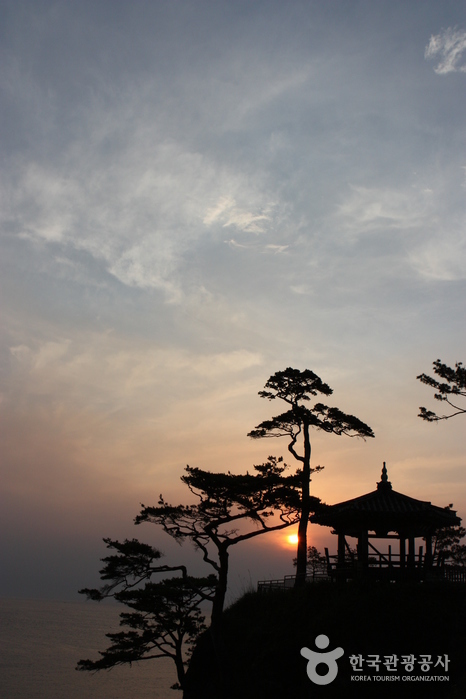

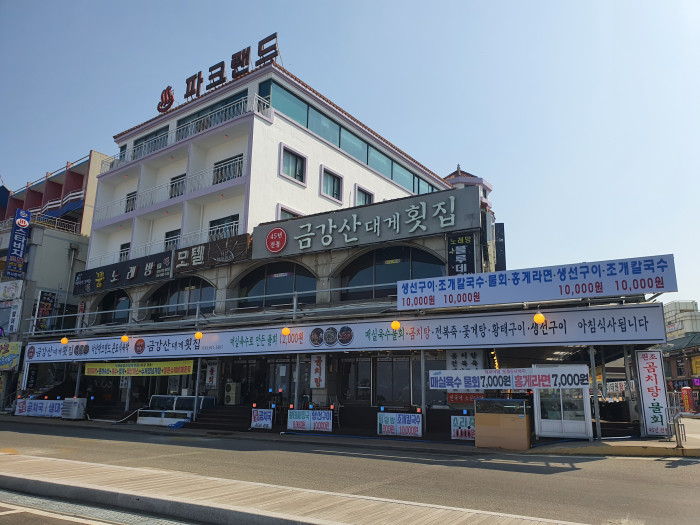
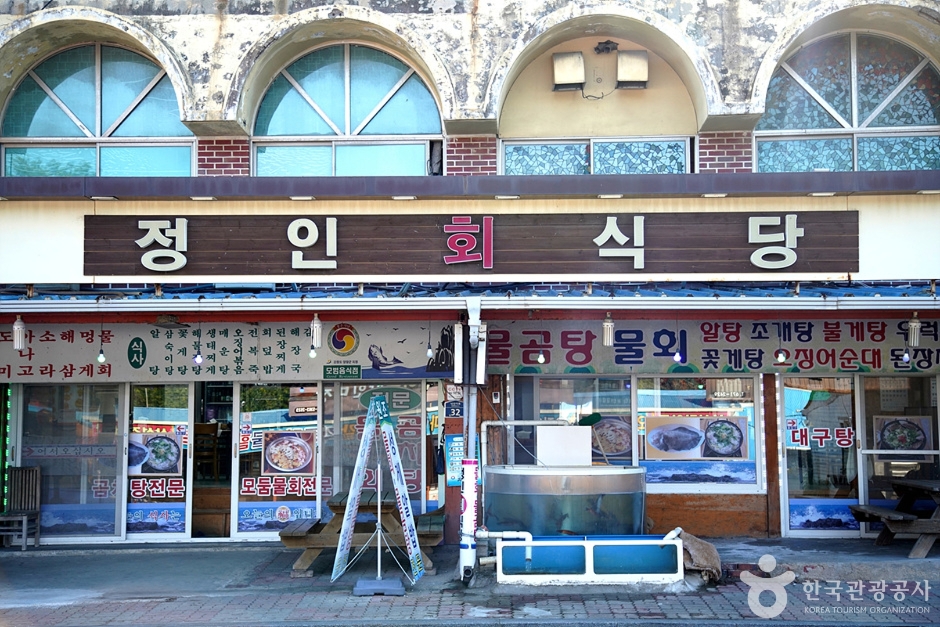
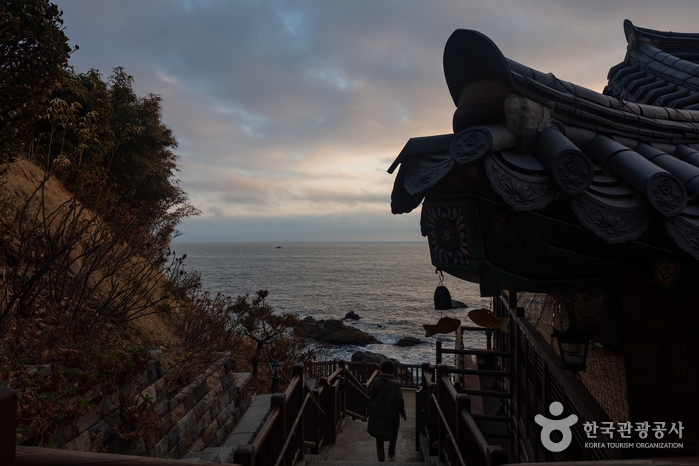
![EL Hotel [Korea Quality] / 이엘호텔 [한국관광 품질인증/Korea Quality]](http://tong.visitkorea.or.kr/cms/resource/12/2709312_image2_1.jpg)
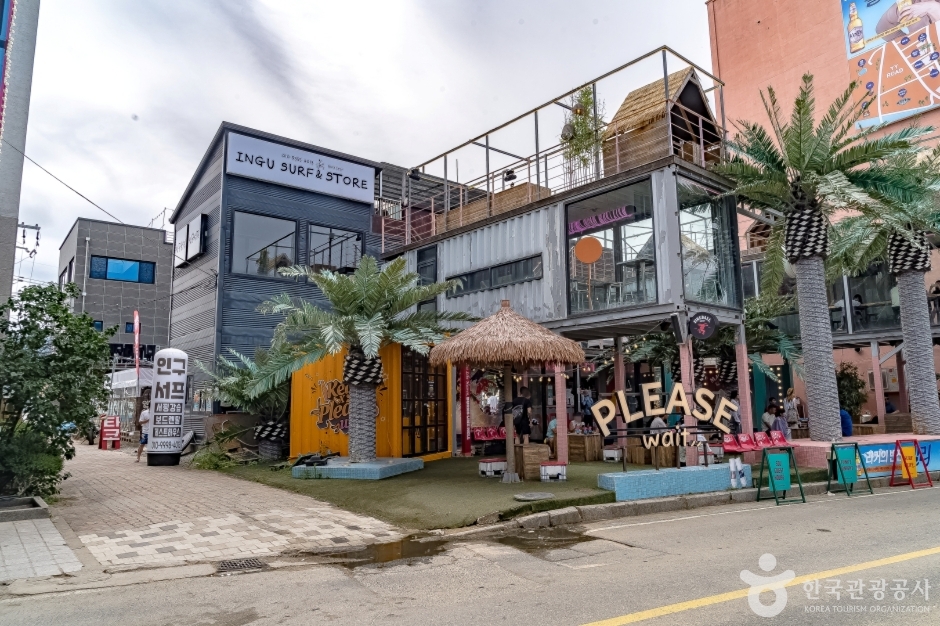
 English
English
 한국어
한국어 日本語
日本語 中文(简体)
中文(简体) Deutsch
Deutsch Français
Français Español
Español Русский
Русский